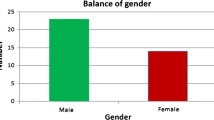Abstract
Background and objectives
The number of emergency radiology (ER) training programs in North America is small compared to the projected growth in demand for ER-trained radiologists. To date, there is no consensus-based training curriculum that sets a standard for all ER fellowship training programs. This study seeks to (1) identify the programmatic measures currently used in North American ER fellowship programs and (2) gather the perspectives of existing ER fellowship program directors (PD) and their recommendations for minimum and ideal curricular standards.
Methods
We distributed an 18-question survey to the PDs of every North American ER fellowship program (N = 15). Surveys were completed during the 2016–2017 academic year. We performed a cross-sectional analysis to gain an understanding of existing training curricula, expected areas of competency by the end-of-training, and PD opinions of what a standard ER training curriculum should contain.
Results
The data revealed heterogeneity in programmatic structure across the continent, as well as some areas of agreement. PD suggestions for a standard ER training curriculum showed consistency in many areas, including competency and proficiency expectations and clinical exposures, with some variability. These data were used to inform the creation of the first curricular standard for ER fellowship training.
Conclusion
This study yielded the creation of a standard fellowship training resource for the field of ER. This deliverable serves as a curricular guideline for existing ER fellowships, as well as a model for new ER fellowship programs.



Similar content being viewed by others
References
Baker SR, Luk L, Clarkin K (2010) The trouble with fellowships. J Am Coll Radiol 7(6):446–451. https://doi.org/10.1016/j.jacr.2010.01.020
Goodman CJ, Lindsey JI, Whigham CJ, Robinson A (2000) Diagnostic radiology residents in the classes of 1999 and 2000: fellowship and employment. AJR Am J Roentgenol 174(5):1211–1213. https://doi.org/10.2214/ajr.174.5.1741211
Shetty SK, Venkatesan AM, Foster KM, Galdino GM, Lawrimore TM, Davila JA (2005) The radiology class of 2005: postresidency plans. J Am Coll Radiol 2(10):852–858. https://doi.org/10.1016/j.jacr.2005.03.011
ASNR at a glance (2018) American Society of Neuroradiology
American Society of Emergency Radiology, fellowship training positions 2018 [updated 2018; cited 2017]. American Society of Emergency Radiology, Fellowship Training Positions]. Available from: https://aser.org/page/Fellowshp_Training
Friedman DP, Pramanik BK (2001) Fellowship and practice trends in neuroradiology training programs in the United States. AJNR Am J Neuroradiol 22(9):1650–1653
Hanna TN, Shekhani H, Lamoureux C, Mar H, Nicola R, Sliker C, Johnson JO (2017) Emergency radiology practice patterns: shifts, schedules, and job satisfaction. J Am Coll Radiol 14(3):345–352. https://doi.org/10.1016/j.jacr.2016.09.018
Wagner MG, Fischer MR, Scaglione M, Linsenmaier U, Schueller G, Berger FH et al (2017) Subspecialisation in emergency radiology: proposal for a harmonised European curriculum. GMS J Med Educ 34(5):Doc61. https://doi.org/10.3205/zma001138
Farria DM, Salcman J, Monticciolo DL, Monsees BS, Rebner M, Bassett LW (2014) A survey of breast imaging fellowship programs: current status of curriculum and training in the United States and Canada. J Am Coll Radiol 11(9):894–898. https://doi.org/10.1016/j.jacr.2014.02.005
Monticciolo DL, Rebner M, Appleton CM, Newell MS, Farria DM, Sickles EA, Umphrey HR, Butler PF (2013) The ACR/Society of Breast Imaging Resident and Fellowship Training Curriculum for breast imaging, updated. J Am Coll Radiol 10(3):207–10 e4. https://doi.org/10.1016/j.jacr.2012.07.026
Goske MJ (2003) Radiology fellowship curriculum: a sample 10-month guide with goals, objectives, and monthly checklists. Acad Radiol 10(7):761–780
Herr KD, Risk B (2018) Hanna TN. Diagnostic radiology resident perspectives on fellowship training and career interest in emergency radiology, Emerg Radiol. https://doi.org/10.1007/s10140-018-1633-8
Funding
TNH and KDH are 2017–2018 recipients of the American Society of Emergency Radiology Educational Grant.
Author information
Authors and Affiliations
Corresponding author
Ethics declarations
Conflict of interest
The authors declare that they have no conflicts of interest.
Rights and permissions
About this article
Cite this article
Chahine, A.H., Hanna, T.N., Myers, L. et al. The state of emergency radiology fellowships in North America and the development of a standardized curriculum. Emerg Radiol 26, 53–58 (2019). https://doi.org/10.1007/s10140-018-1657-0
Received:
Accepted:
Published:
Issue Date:
DOI: https://doi.org/10.1007/s10140-018-1657-0




